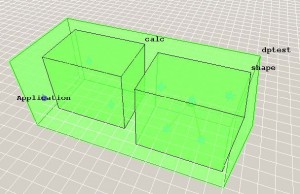
Bc. Ivan Ruttkay-Nedecký
Abstract. Program execution consists of many abstract processes. In order to understand the whole program, one has to understand these processes first. A good imagination is required. Here visualization takes its part. This work discusses visualization of program execution in 3D environment, which should help to understand algorithms contained in programs. The work describes monitoring of program execution as a sequence of events – method execution, setting a field, a class instance construction etc. Extraction of relevant information for visualization is described. Then the work deals with visualization of these events. It looks for a way, how to visualize program elements (class, instance, method, field) and relations between them (class and its instances, fields and methods) effectively. The work deals with visualization of program execution as a control flow and data flow animation.

 Entities closer to the camera have their full description. Others have only their name.
Entities closer to the camera have their full description. Others have only their name.







